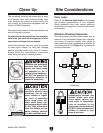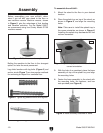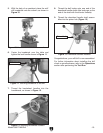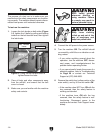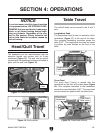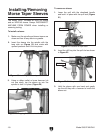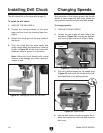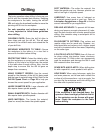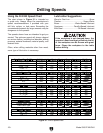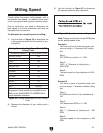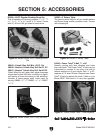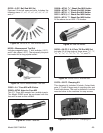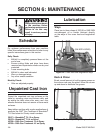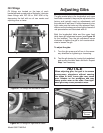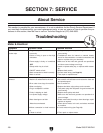
Model G0517 Mill/Drill
-19-
The basic operation when drilling is lining up your
drill bit with the intended hole location, clamping
the workpiece to the table, turning the mill/drill
ON, and using the downfeed handles to move the
spinning drill bit into the workpiece.
For safe operation and optimum results, it
is very important to follow these guidelines
when drilling:
CLEARING CHIPS: Raise the drill bit often to
clear chips and cool the drill bit. This will ease
the work of the mill/drill motor and extend the life
of your drill bits.
SECURING WORKPIECE TO TABLE: Secure
the workpiece to the table or in a vise that is
secured to the table before drilling.
PROTECTING TABLE: Protect the table by plac
-
ing the workpiece on scrap wood, or center the
location of the hole to be drilled over the pocket
in the table when through drilling. Also, use the
depth stop to ensure that the drill bit goes no
deeper than necessary.
USING CORRECT SPEEDS: Use the correct
speed for the diameter of the drill bit being used
and the type of material being drilled. Refer to the
Drill Bit Speed Chart on Page 20
to help you
choose the correct speed for your application.
LARGE DIAMETER BITS: Large diameter drill
bits require slower spindle speeds.
SMALL DIAMETER BITS: Smaller diameter drill
bits require faster spindle speeds.
HARD MATERIAL: The harder the material,
(steel vs. wood) the slower the spindle speed.
Drilling
If the workpiece is not clamped down, the
operator's hand could get pulled into the bit
or the workpiece can be thrown with great
force. Clamp the workpiece to the table
before drilling.
SOFT MATERIAL: The softer the material, the
faster the spindle may turn. However, plastics can
melt at too high of a spindle speed.
LUBRICANT: Use some form of lubricant on
all materials except wood or cast iron. Refer to
Lubrication Suggestions on Page 20
to find the
correct lubrication for your application.
DRILLING ACCURACY: To prevent drill bit wan
-
dering and ensure accurate placement of holes,
mark the hole location with a center punch before
drilling. Also consider using a center-point drill to
start the hole.
PLUG/ROSETTE CUTTERS: Plug cutters and
rosette cutters are for wood only. However, car
-
bide-tipped bits and cutters cut at a higher speed
and can cut materials other than wood, depending
on the cutter type.
5-FLUTE/2-FLUTE CUTTERS: Use a 5-flute cut
-
ter when cutting into plastics, brass, aluminum,
and mild steel. A 2-flute cutter can aggressively
grab the workpiece and damage the tool if used
with materials other than wood.
SPADE BITS AND PLASTIC: When drilling plas
-
tic with a spade bit, use a spade bit with spurs.
HOLE SAWS: When using hole saws, apply firm
and even pressure, so the saw teeth contact the
surface all at the same time—not at an angle. You
can also flip the workpiece and finish drilling from
the other side to prevent tear-out.



